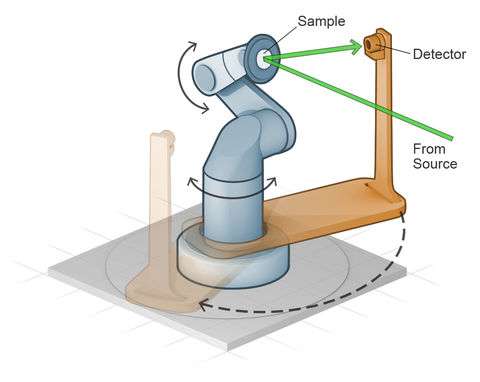NIST to launch a dramatically improved system for measuring the intensity and spectrum of light

We see the world in reflection: Nearly all the light that enters our eyes has bounced off something first, bringing with it information about the nature of the objects it encountered on the way. But that information is strongly affected by the angle at which the light strikes the object, and also the angle at which the reflected light reaches the eye of the beholder.
That's why the properties of light reflected at different angles and intensities are enormously important, for example, to the way cars are painted, fabrics are made, plastics and coatings are colored, printed materials are produced, optical systems are engineered, and remote-sensing images are created and interpreted, to name only a few.
Moreover, instruments deployed for many public service and national security uses—such as satellite monitoring of weather and natural disasters, or detecting activity by potential adversaries—contain components that must be precisely calibrated against a known standard to ensure accurate characterization of the effects of light reflectance and scattering.
NIST maintains the national scale for reflectance, and now is about to launch a dramatically improved system for measuring the intensity and spectrum of light reflected and scattered off samples as large as 30 cm square in practically any direction. Called the Robotic Optical Scattering Instrument (ROSI), it will offer new capabilities that are in increasing demand by industry and science, but were not previously available at NIST.
"We began work to develop this system years ago," says project leader Heather Patrick of NIST's Physical Measurement Laboratory, "arriving at progressively more sophisticated designs before the current version of ROSI. By the middle of 2017 we expect to make the first set of functions available to customers. About a year later, all of the system's features will be fully operational."
Perhaps most importantly, ROSI will permit both in-plane and out-of-plane measurements. (See diagram below.) In the former, the light source, the sample, and the receiver are all in the same plane; in the latter, the receiver is in a different plane.
Out-of-plane measurements were not possible with ROSI's predecessor, NIST's workhorse Spectral Tri-function Automated Reference Reflectometer (STARR). "But they are important to anyone who does reflectance measurements in the field, such as those who study ocean color or infrared monitoring of heat signatures," says NIST scientist Catherine Cooksey. "In addition, they are important to 'gonioapparent' coatings—that is, coatings that reflect different colors depending on the direction of viewing or illumination, like iridescent colors. For example, car paint that seems to change colors as you move around the car."

In addition, ROSI extends the range of wavelengths from the ultraviolet to the near-infrared, and can provide 100 times more incident light than STARR, enabling detailed measurements of samples with low reflectance and opening new possibilities for research.
The ROSI system combines three integrated, fully automated components (see diagram). One is a laser-based light source that can be tuned to a specific desired color, intensity, and polarization before it is focused on the sample to be studied. The beam makes a spot 1 cm in diameter when shining exactly perpendicular to the surface of the sample, but broadens to an ever-wider and fainter ellipse as the angle between the source and sample becomes increasingly oblique.
The sample is mounted on the end of ROSI's second major component, a 6-axis robotic arm that can move the sample into almost any angle with respect to the beam. The third component is the receiver which detects the amount of light scattered from the sample at a specific viewing angle. The receiver can be moved around the axis of the robot arm, a design that facilitates out-of-plane measurements.
That capacity is critically important for characterizing the materials that satellite systems such as the long-running Landsat series —which maps changes in the global landscape—use to calibrate their on-board sensors. Those devices receive reflected and scattered light arriving from a wide array of angles, and the quality of observations depends on understanding the way that those angles affect the signal. The impact is large: Since Landsat 8's launch in 2013, more than 30 million images have been downloaded from the program site.
NASA provides many of its other satellite projects with reflectance measurements, and NASA's reflectance scale is traceable to the national reflectance scale through yearly NIST calibrations.
ROSI is designed to make three kinds of measurements. The least complex involves mirror samples, in which nearly all the incident light is reflected at one angle. That is the first capability that will come online later this year. The second kind goes by the name of bidirectional reflectance distribution function (BRDF), which basically means that both the angle at which the incident light strikes the sample and the angle between the sample and the receiver can be separately adjusted to measure how the changes modify the properties of the reflected/scattered light.
Finally, ROSI will be able to produce "hemispherical" measurements in which light reflected from the sample is recorded at numerous points constituting a complete hemisphere and producing a comprehensive data set.
"This new facility offers NIST's customers an expanded capability, and NIST itself with extended research potential," Cooksey says. "Previously, we could only measure within a single plane. Now we can measure full hemispherical space above a sample point by point with significantly increased intensity of incident light. This increases the types of materials we can now measure, such as coatings with interesting BRDFs or very dark, black samples."
Provided by National Institute of Standards and Technology





















